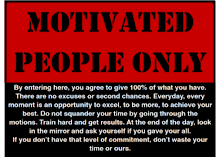Day 15 of the "100 burpee challenge"
WOD - "Annie"
50-40-30-20-10 reps for time:
Double-unders
Sit-ups
Everyone who is arrogant in heart is an abomination to the LORD; be assured, he will not go unpunished.
Proverbs 16:5
Energy and persistence conquer all things.
-Benjamin Franklin
Just passing along a clip about milk that I read on a Live Primal blog:
One of the biggest questions about being primal/paleo is the lack of dairy in our diets. Usually the first question from non-primal people is “If you don’t drink milk, then where do you get calcium?”
The dairy industry, including the National Milk Processor Board (MilkPEP), has definitely been successful in their marketing campaign. We’ve all heard the slogan “Got Milk?” and huge amounts of money and celebrity endorsements have helped make milk popular. As the WhyMilk? site states: “What is it about being a milk drinker? Just take a look at some of country’s most popular actors, athletes, models and musicians who have proudly worn a milk mustache. It’s no coincidence that these healthy and fit celebrities embody the true meaning of wellness.”
We primals have to ask – do they really?
Those of us who say “Forget Milk” are definitely in the minority. The marketers have promoted milk as the only source of calcium and have also touted it as the “cure” for diseases like osteoporosis. Yet studies have shown that milk does not help bones; regular exercise is the main factor in bone density.
So what is the evidence to support the primal theory that milk is actually not “nature’s wellness drink”?
History. If we look at our cavemen and cavewomen ancestors, they did not have domesticated animals. Thus, they probably did not drink animal milk. The only milk in their diets would be human breast milk. Breast milk is entirely natural and Paleo newborns were most likely breastfed. Yet it’s highly unlikely that milk was part of a caveman’s diet at any other time.
Nature. Humans today are the only animals that consume milk beyond infancy. Most people find consuming human breast milk after a certain time be quite odd, if not repulsive. In nature, no other mammals continue to consume their own milk into adulthood. Even cows do not consume milk past their infant stage. So why is there the push for us to consume cow baby food?
Biology. If you look at the natural progression of our bodies (and, in fact, all mammals), the production of the enzyme lactase that is needed to absorb lactose declines after infancy. So many humans cannot digest lactose. Also, many of our immune systems have allergic reactions to one or more milk proteins. For some the allergy to milk may just be discomforting; for others it can be intense and even life threatening.
So why would we drink or eat something that our ancestors never did, is unnatural after we have teeth and can eat solid food, and can cause major health problems?
We can find all of the calcium we need for our bodies in other sources, just as our ancestors did. These other sources are also natural and not “fortified” with other ingredients or laden with sugars and added fats, chemicals, and preservatives. Not surprisingly, these natural foods are on our primal fuel lists.
Milk and Milk Products Calcium Content
Yogurt, plain, low-fat, vitamin D-fortified, 1 cup 415 mg
Milk, reduced fat, vitamin D-fortified, 1 cup 285 mg
Swiss cheese, 1 oz. 224 mg
Cottage cheese, 1/2 cup 87 mg
Ice cream, 1/2 cup 84 mg
Non-Milk Products Calcium Content
Sardines, with bone, 3 oz. 325 mg
Spinach, frozen, cooked, 1 cup 291 mg
Collards, cooked, 1 cup 266 mg
Almonds, 100 g 264 mg
Salmon, canned, with bone, 3 oz. 181 mg
Brazil nuts, 100 g 160 mg
Parsley, raw, 100 g 138 mg
Kale, cooked, 1 cup 94 mg
Oysters, cooked 3 oz. 76 mg
Orange, 1 medium 61 mg
Shrimp, raw 3 oz. 44 mg
Broccoli, raw, 1 cup 43 mg
Lettuce greens, 1 cup 20 mg
Fig, raw, medium 18 mg
Tuna, white, canned, 3 oz. 12 mg
From the USDA National Nutrient Database for Standard Reference.
The National Institute of Diabetes and Digestive and Kidney Diseases also lists other foods that contain milk. You will note that these foods are on our non-primal fuel lists (and for other reasons, in addition to milk content).
bread, baked goods like doughnuts, pastries, rolls
waffles, pancakes, biscuits, cookies, and mixes to make them
processed breakfast cereals
instant potatoes, soups, and breakfast drinks
potato chips, corn chips, and other processed snacks
processed meats like bacon, sausage, hot dogs, lunch meats
margarine
salad dressings
liquid and powdered milk-based meal replacements
protein powders and bars
candies
non-dairy liquid and powdered coffee creamers
non-dairy whipped toppings
So if you add up the history of milk, the nature of animals, our own biology, and the many other natural fuel sources that contain calcium, why should we drink milk?
As Robert Cohen succinctly states: “Why do we LOVE cow’s milk? We’ve been brainwashed.”
Gluten Free Chicken Salad with Almonds
2 cups chicken, shredded (use last night's chicken)
1 cup slivered almonds, toasted1 cup dried cranberries
3 apples, sliced and chopped
4 cups mesclun greens
½ cup olive oil
¼ cup balsamic vinegar
¼ teaspoon celtic sea salt
Place the almonds in a pan over low heat and toast them, while you core, slice and chop the apples
Remove almonds from heat when they are lightly browned
In a large salad bowl, toss together chicken, (warm) almonds, cranberries, chopped apples and mesclun greens
Drizzle with olive oil and vinegar, toss, then sprinkle with salt and Serve
Serves 6 to 8
Be Strong and Conquer Your Weakness!
Jay and Janice





















No comments:
Post a Comment